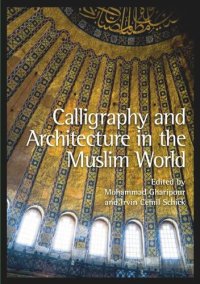
Ebook: Calligraphy and Architecture in the Muslim World
Author: Mohammad Gharipour, Irvin Cemil Schick
- Year: 2013
- Publisher: Edinburgh University Press
- Language: English
- pdf
Explores the myriad interactions between calligraphy and architecture throughout the history of the Muslim world
- 30 case studies explain different aspects and contexts of calligraphy in Islamic architecture
- Geographically wide-ranging – covers North Africa, the Middle East, South Asia, China and Spain
- Takes an interdisciplinary approach to analysing calligraphy as part of its larger spatial-architectural context
- Lavishly illustrated with over 300 colour images
From Spain to China, Islamic architecture and calligraphy are inexorably intertwined. Mosques, dervish lodges, mausolea, libraries, even baths and market places bear masterpieces of calligraphy that rival the most refined of books and scrolls.This major reference work focuses on architectural inscriptions through the Muslim world, from the emergence of Islam to the present day.
- What were the purposes of these inscriptions?
- How do they infuse buildings with culturally specific meanings, sacred or profane?
- What do they add to architectural design?
- What sorts of materials were used, and how do they interact with light and space?
- Who were their patrons, and what do we know about the artists who produced them?
Find out with this exciting new collection edited by a stellar cast of international contributors.
About the Contributors
Nasiba Baimatowa, Harvard University, USA
Bavand Behpoor, Ludwig Maximilian University of Munich, Germany
Süleyman Berk, Yalova University, Turkey
Sheila S. Blair, Boston College and Virginia Commonwealth University, USA
Johanna Blayac, University Paris 8 Saint-Denis, France
Patricia Blessing, Stanford University, USA
Snježana Buzov, Ohio State University, USA
M. Uğur Derman, independent
Edhem Eldem, Boğaziçi University, Turkey
Nina Ergin, Koç University, Istanbul, Turkey
Mohammad Gharipour, Morgan State University, USA
Sina Goudarzi, independent
Sadiq Javer, Tsinghua University in Beijing, China
Hilal Kazan, independent
Saeid Khaghani, Shahrood University of Technology, Iran
Ulrike-Christiane Lintz, Saarland University, Germany
Tehnyat Majeed, Beaconhouse National University, Lahore, Pakistan
Talip Mert, Marmara University, Turkey
Bernard O’Kane, American University in Cairo, Egypt
José Miguel Puerta Vilchez, University of Granada, Spain
İrvin Cemil Schick, İstanbul Şehir University, Turkey
Ann Shafer, American University in Cairo, Egypt
Bahia Shehab, Mi7-Cairo and American University in Cairo, Egypt
Sumayah Al-Solaiman, University of Dammam, Saudi Arabia
Barbara Stöcker-Parnian, Ludwig-Maximilians-University Munich, Germany
Murat Sülün, Marmara University, Istanbul, Turkey
Hashim Al-Tawil, Henry Ford Community College, USA
Abdülhamit Tüfekçioğlu, Yüzüncü Yıl University, Van, Turkey
Caroline Olivia M. Wolf, Rice University, USA